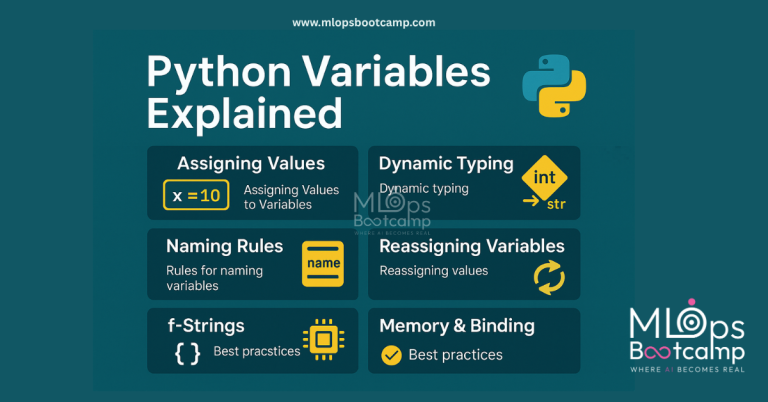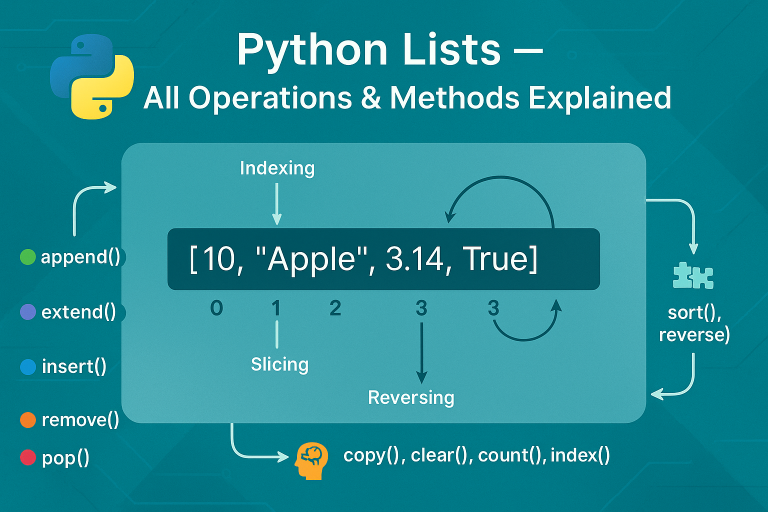Introduction to Python Numbers and Strings
Python Numbers and Strings Explained — The Ultimate 2026 Beginner’s Guid. In Python, numbers and strings are the two most fundamental data types. Whether you’re building a calculator, analyzing data, or processing text, understanding how Python handles numbers and strings is essential.
Numbers and strings are the building blocks of Python programming.
Every application — from data analysis to machine learning — uses these data types.
- Numbers help you perform calculations, build algorithms, and manage logic.
- Strings let you store and manipulate text, from usernames to file names.
Let’s explore how these data types work, how to convert between them, and what operations you can perform on each.
What Are Python Numbers?
Python supports three main number types: integers, floats, and complex numbers.
Each type serves a different purpose, making Python flexible for various real-world problems.
In the sections below, you’ll see examples that are not only practical but also relevant to daily-life programming tasks.
1. Integer in Python Numbers (int)
Integers represent whole numbers — positive, negative, or zero. You’ll use them for counting, indexing, and mathematical operations.
For example:
a = 10
b = -5
c = 0Instead of handling only small numbers, Python automatically supports large integers without overflow errors. In addition, integers integrate smoothly with other types like floats during mixed operations.
1.1 Performing Arithmetic with Python Numbers
Let’s look at how integers behave in different arithmetic calculations. For example:
print(a + b) # Addition
print(a - b) # Subtraction
print(a * b) # Multiplication
print(a / 2) # Division (float result)
print(a // 2) # Floor division
print(a % 3) # Modulus
print(a ** 2) # ExponentiationFurthermore, the use of // for floor division ensures your output remains an integer — particularly useful in pagination, index slicing, or mathematical rounding.
You can perform all basic arithmetic operations seamlessly. Moreover, Python automatically handles large integers without overflow errors — a big advantage over languages like C or Java.
2. Float in Python Numbers (float)
Floats represent numbers with decimals, such as 3.14 or 99.99. These are essential for financial transactions, scientific measurements, and statistical analysis.
Example:
pi = 3.14159
price = 19.9In addition, when you divide two integers in Python, the result automatically becomes a float, which ensures mathematical accuracy.
However, due to floating-point precision, some results might display tiny decimal errors.
To avoid this, you can use the round() function for clean formatting.
2.1 Performing Arithmetic with Python Float Numbers
For example, if you want to calculate the area of a rectangle:
length = 5.5
width = 2.0
area = length * width
print(area) # 11.0Floating Point Precision, due to binary representation, floats can have rounding issues, using round() function to fix it
x=0.1
y=0.2
z= x + y
print(z) # 0.30000000000000004
round(z)3. Complex Numbers in Python (complex)
Python complex numbers include a real and an imaginary part. Useful in engineering, signal processing, and AI computations.
Example:
z = 2 + 3j
print(z.real) # 2.0
print(z.imag) # 3.0Interestingly, complex numbers are commonly used in engineering, signal processing, and AI model computations. Therefore, learning how they behave is valuable if you plan to work with scientific or electrical applications.
4. Type Conversion Between Number Types
Type conversion helps you move smoothly between integer, float, and complex types.
This becomes especially useful when working with data from user input, APIs, or files.
int(9.8) # 9
float(5) # 5.0
complex(3) # (3+0j)For example, when you’re processing input data, you can ensure it’s the right type before performing calculations.
Working with Python Strings
Strings store text-based information everything from user names to error messages. They’re enclosed in single (' '), double (" "), or triple quotes (""" """).
name = "Python"
message = 'Hello World'
multiline = """This is
a multi-line string."""1. Indexing and Slicing Python Strings
Strings are indexed just like lists. This means you can access or slice any character easily.
word = "Python"
print(word[0]) # P
print(word[-1]) # n
print(word[1:4]) # ythFor example, reversing a string is as simple as:
print(word[::-1]) # nohtyP2. Common Methods in Python Numbers and Strings
Python includes several built-in methods to make text manipulation simple and fast.
text = " python programming "
print(text.strip()) # Removes extra spaces
print(text.upper()) # Converts to UPPERCASE
print(text.lower()) # Converts to lowercase
print(text.title()) # Title Case
print(text.replace("python", "Java")) # Replace textIn addition, you can check if strings start or end with specific substrings:
email = "info@example.com"
print(email.endswith(".com")) # True3. Concatenation and Repetition in Python Strings
You can join or repeat strings easily using + and *. Therefore, string operations are essential in chatbots, reports, and logs.
first = "Python"
second = "Rocks"
print(first + " " + second) # Python Rocks
print(first * 2) # PythonPython4. String Formatting (f-Strings)
Modern Python formatting uses f-strings for clarity and simplicity.
name = "Alice"
age = 25
print(f"My name is {name}, and I am {age} years old.")5. Type Conversion Between Numbers and Strings
Converting between numbers and strings is common in user input or data processing.
num = 123
str_num = str(num)
print(type(str_num)) # strConversely, to turn a string into a number:
price = "99.99"
float_price = float(price)
print(float_price + 10) # 109.99Common Errors Beginners Mistakes
| Error | Description | Example |
|---|---|---|
| TypeError | Mixing string and number without conversion | "Age: " + 25 ❌ |
| ValueError | Invalid string-to-number conversion | int("abc") ❌ |
| IndexError | Accessing character out of range | "Hello"[10] ❌ |




Leave a Comment